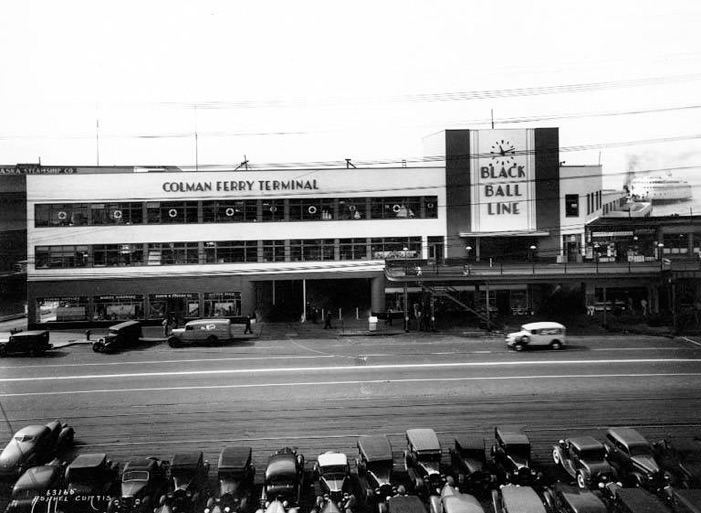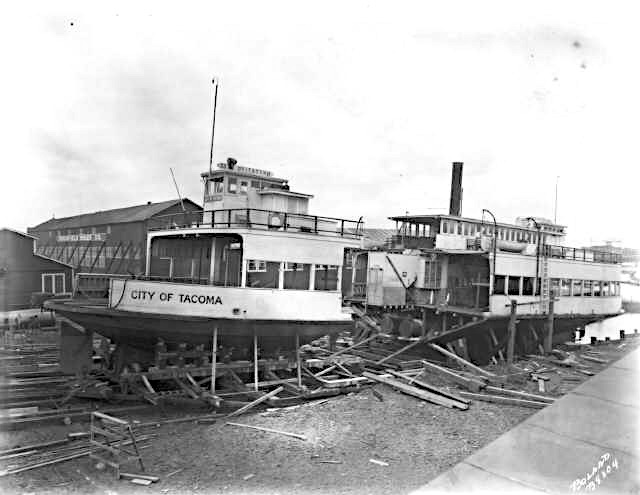City of Tacoma


City of Tacoma
The Pacific Northwest has a long maritime history of passenger ferry transportation in and around the Puget Sound. Before the 20th century, vessels part of what was known as the “Mosquito Fleet” would provide service across the many waterways of the evergreen region buzzing like insects on routes between Seattle, Tacoma, Olympia, Port Townsend, Vashon Island, Bremerton, Everett, Bellingham, Canadian Islands, as well as other Puget Sound ports and smaller ports along Lake Washington.
In 1856 the Territorial Legislature passed an act allowing for the operation of the first ferry across the Columbia River (although the first non-sanctioned passenger ferry consisting of two tied together canoes came first in 1840, 44 years earlier than the Squak; the first passenger scow of Lake Washington). Its terminal was located at Chinookville, Washington (now Chinook, near the mouth of the Columbia River), and they continued to run until the completion of bridges across the Columbia in the late 1800’s.
In 1888 the first vehicle ferry to operate on the Puget Sound was built in Portland Oregon and called the City of Seattle. A side-wheel steamer in design, she measured 121.5 x 33.2 x 8.6 and weighed in at 272 tons. She ran the Seattle (from Main and Madison streets) to West Seattle run until 1911.

Courtesy UW Archives
By 1910 Puget Sound Navigation Co., operating under the name of the Black Ball Line, carried 2 million passengers a year, and was quickly becoming one of the leaders in the ferry business.
Another company started by 5 Hunt brothers; Arthur, Arda, Lloyd, Emmett, and A.M. was called the Tacoma Ferry Company and in December 1921 launched the City of Tacoma for her maiden voyage on the Tacoma, Vashon, and Gig Harbor route under contract of the Pierce County Commissioners. Designed by Arthur Hunt, the City of Tacoma was registered at 113.2 feet long, 43.6 feet wide and 9.4 feet deep and she had a capacity of 35 automobiles and 300 passengers. Her maiden voyage was for honored guests, and after that it was to be assigned to her home slip at Point Defiance.

Courtesy Ferries of Puget Sound
In 1924 the Tacoma was deemed too small for the competing vessels at the time. With more and more people traveling by ferry, the new boats emerged even larger. Even though she shared the loads with the Gloria on the same runs, it was deemed necessary to lengthen the small boat. Built to be stretched in length, the City of Tacoma was sent to the Western Boatbuilding Co. plant, cut in half, lengthened 34 feet, and in February 1924, she was sent back to work with a new load capacity of 50 automobiles.

Courtesy Tacoma Public Library

The City of Tacoma continued her faithful service for several more years. In 1927, the ferry then operated by the Skansie Bros. company, the Washington Navigation Co., was sent to the Skansie Bros. Yard in Gig Harbor to be re-engined with two 180-horsepower diesels to replace her aging steam engines.
When she was re-registered with the state on May 25, 1932 she had gained another 4 feet in length and 11 more gross tons.
1938 brought drastic changes to the Tacoma ferry service. The construction of the new Tacoma Narrows Bridge would systematically decrease the demand of many of the busy ferries. The bridge was completed in 1940 but soon after collapsed in a severe wind storm. The City of Tacoma and other ferries were back in business, the new bridge wouldn’t be re-built until 1950.

City of Tacoma sailing next to Narrows Bridge construction-Tacoma Public Library
On June 7, 1948 the City of Tacoma, then owned by Mrs. Amanda Skansie and Joseph Skansie, mother and uncle to the Skansie brothers, was to be sold in an agreement to the Vashon-Maury Island Ferry District for $45,000. The new route for the ferry would be the Fauntleroy-Vashon Heights run.
Soon thereafter though, in 1949 the state purchased the ferry, because the Coast Guard shut down her service on the Fauntleroy-Vashon run because of her low freeboard. The State Highways Dept. paid $40,074 for the vessel using motor vehicle funds with the understanding it would be re-sold to the State Toll Bridge Authority for use in the state-operated ferry system. Seattle Times
After the completion of the Tacoma Narrows Bridge in 1950 Governor Arthur Langlie decided that the boat could “no longer serve any useful service...charges were accruing for moorage and other costs, so the only practical thing...was to put the boat up for sale.” In March of 1951, the City of Tacoma was sold to a private owner; Dullen Steel Products Inc. of Seattle.
With only one private Puget Sound ferry company left to run the show; the Black Ball Line started loosing money due to the decrease in travel during WWII. It’s response was to raise fares, which led to the Transportation Commission to order a roll back, which prompted the BBL to terminate the charter for ferry service with the state. The state retorted with legislation authorizing the purchase of the Black Ball Line for 4.9 million dollars. On that day, May 31st, 1951, the BBL became what is now known as the Washington State Ferry system.
September 29, 1952 was the last known date the City of Tacoma was registered with Washington state. Her long history of running her routes strong and proud came to an official end.
In 1962, following a very blank 10 years of historical significance, she was towed to the Yarrow Bay Marina at Houghton on Lake Washington to be used as a breakwater and storage barge.
In the beginning of March, 1964 the City of Tacoma started to list.

Courtesy Seattle Times
Honorably poised for 5 additional years on Lake Washington, standing guard as a barrier to the shores and vessels born after her, the City of Tacoma sadly relinquished and foundered in July of 1969. She now lies in 8-25 feet of water.

Courtesy Rogues Gallery
Courtesy Ferries of Puget Sound


-
-Home
